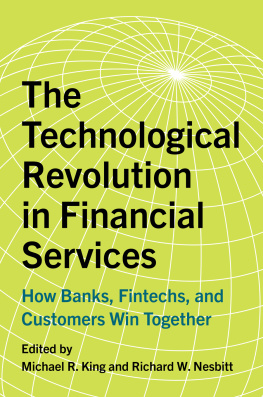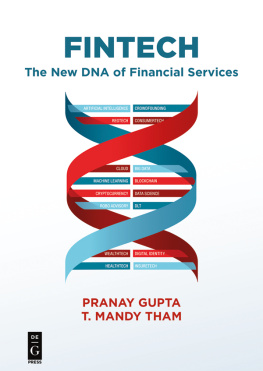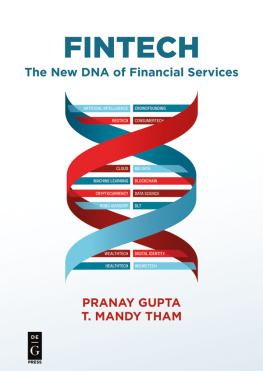Advance Praise for The Technological Revolution in Financial Services
The financial crisis of 20082009 reshaped global banking regulations. How will changes in technology and consumers demand affect the finance industry in the post COVID-19 world? This book identifies the most important trends and challenges, and provides invaluable insights for managers, policymakers, and consumer advocates.
Thomas Philippon, Max L. Heine Professor of Finance, Stern School of Business, New York University
King and Nesbitt have edited a comprehensive book on how the financial services industry is being disrupted by fintech. This book details new strategies and business models arising from fintech. It does an excellent job laying out the broad forces transforming the financial services industry.
Raghavendra Rau, Sir Evelyn de Rothschild Professor of Finance, Co-founder and Academic Director, Cambridge Centre for Alternative Finance, Cambridge Judge Business School, University of Cambridge
This book reaffirms my assertion that banking is being fundamentally changed by technology, but will survive with some new players and some old players coming together in a new model of providing and distributing value.
Chris Skinner, CEO of The Finanser, Chair of The Financial Services Club, and Author of Doing Digital, Digital Bank, ValueWeb, and Digital Human
King and Nesbitt have put together an excellent collection of articles in this book that sheds valuable light on the dynamics of the future evolution of the financial services industry with the expanding role of fintech and the possible competitive challenges banks and other traditional players will face from information technology firms like Google. This book is an essential read for banking scholars, regulators, and financial service executives seeking insights into future strategies to cope with these seismic changes.
Anjan Thakor, John E. Simon Professor of Finance, and Director of the WFA Center for Finance and Accounting Research, Olin School of Business, Washington University in St. Louis
King and Nesbitt have brought forth a great perspective on the digital transformation happening at every level of the financial services sector. This is a reference book to put into every hand across the industry.
Peggy Van De Plassche, Managing Partner, Roar Growth
A very timely compendium of informed and insightful analyses and forecasts of the effects of technology on the structure, dynamics and organizational architecture of the financial services industry. I highly recommend this to both technologists eyeing opportunities for change and long-time incumbents of this overly established industry.
Mihnea Moldoveanu, Vice Dean, Learning, Innovation and Executive Programs, Desautels Professor of Integrative Thinking, and Professor of Economic Analysis, Rotman School of Management, University of Toronto

Instructor resources for this book are available on a tab on the books webpage via the University of Toronto Press website: utorontopress.com
The Technological Revolution in Financial Services
How Banks, Fintechs, and Customers Win Together
Edited by Michael R. King and Richard W. Nesbitt
Foreword by Paul Desmarais III
UNIVERSITY OF TORONTO PRESS
Toronto Buffalo London
University of Toronto Press 2020
Rotman-UTP Publishing
Toronto Buffalo London
utorontopress.com
Printed in Canada
ISBN 978-1-4875-0602-5 (cloth)
ISBN 978-1-4875-3313-7 (PDF)
ISBN 978-1-4875-3314-4 (EPUB)
Library and Archives Canada Cataloguing in Publication
Title: The technological revolution in financial services : how banks, fintechs,
and customers win together / edited by Michael R. King and Richard
W. Nesbitt.
Names: King, Michael R. (Michael Robert), 1967 editor. | Nesbitt, Richard,
1955 editor.
Description: Includes bibliographical references.
Identifiers: Canadiana (print) 20200252631 | Canadiana (ebook) 20200252879 |
ISBN 9781487506025 (cloth) | ISBN 9781487533144 (EPUB) |
ISBN 9781487533137 (PDF)
Subjects: LCSH: Financial services industry Technological innovations. |
LCSH: Financial Institutions Technological innovations. | LCSH: Finance
Technological innovations.
Classification: LCC HG173 .T43 2020 | DDC 332.1 dc23
University of Toronto Press acknowledges the financial assistance to its publishing program of the Canada Council for the Arts and the Ontario Arts Council, an agency of the Government of Ontario.

I dedicate this book to my wife, Yanna, and our sons, Robert and Peter, who have supported my academic journey.
Michael R. King
This book is dedicated to my family: Lucy, who has been a constant supporter and partner; my wonderful daughters, Olivia and Lillian, who have now finished their university degrees and are on to their own great adventures. I would not be anything without them.
Richard Nesbitt
Contents
Michael R. King and Richard W. Nesbitt
R. Jesse McWaters
Jon Frost
Tiff Macklem
Brian ODonnell
Markos Zachariadis
Gregory P. Wilson
Michael R. King
Jay Wilson
Andrew Graham
Richard W. Nesbitt and Satwik Sharma
Chuck Grace and Andrew Sarta
Peter Levitt and Tom McGuire
Evan Siddall and Vicki Martin
Brenda Trenowden
Richard W. Nesbitt
Michael R. King and Richard W. Nesbitt
Figures and Tables
Figures
Tables
Foreword
As the CEO of Sagard Holdings and a co-founder of Portag3 Ventures and Diagram Ventures, I am excited by the changes taking place in financial services. We are moving from an industry built on geographic proximity, product offering, and efficiency to one that competes on customer service, product suitability, and adaptability. Historically, the business and service models of many financial institutions revolved around the local branch or regional office. These outposts were spread across the country, serving geographic catchment areas. For customers, the competitive differentiators were branch accessibility and access to a wide range of financial products that met their personal and business needs. For financial institutions, the quest for economies of scale drove a strategy of building highly integrated businesses. The customer experience was poor, featuring complicated onboarding, long wait times, and highly inflexible systems.
Our world is changing rapidly. We are moving from a financial industry that competes on local presence and generic products to one focused on specialized products tailored to each customers needs. Customers are no longer constrained by physical proximity. They are supporting businesses that differentiate themselves based on convenience, service, specialization, and product suitability. The This customization was not possible in the geographically constrained world of the past; there were simply not enough clients in a specific industry or targeted demographic within the branch catchment area to justify such an expensive, specialized service.
But end-to-end integration and scale are becoming a handicap more than a competitive advantage as these business models reduce adaptability. Every component of financial services can be outsourced from innovators whose modern technology stacks enable a superior customer service and more efficient operations at a lower cost.












